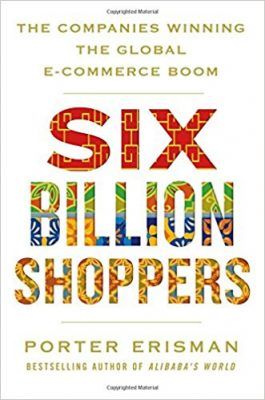
Porter Erisman with Alibaba boss Jack Ma. [A still from Crocodile in the Yangtze.]
This is the second part of an in-depth interview with former Alibaba VP Porter Erisman, who has devoted his time to writing books and advising internet companies after leaving the Chinese tech giant. His second book Six Billion Shoppers released a little over a month ago.
While the first book Alibaba’s World provided an insider’s view of the growth of Alibaba and its founder Jack Ma from their formative years of ecommerce in China in 2000, Six Billion Shoppers draws upon Erisman’s travels in emerging ecommerce markets across Asia, Africa, and Latin America.
The first part of this Tech in Asia interview with Erisman went into the main thesis of the book around a clash of ecommerce models from the West and East in emerging markets. The second part dives deeper into cultural and political differences and how they impact ecommerce strategies.
Amazon, I think, is really going to start looking at Southeast Asia in a serious way because it’s very well set up to sell cross-border into these emerging markets.
In Six Billion Shoppers, Erisman delves into history and behavioral research to support his view that the Chinese are inherently more social than people in the West. This was reinforced during his visits to the rural interior of China in Guizhou province to witness the tight-knit community vital to the success of farming in terraced paddy fields, where water flows from one plot to another. “Unlike the wheat farming of the American West, this was no individualistic pursuit,” he writes. “Sorting out the irrigation routes required the co-ordination of the entire village.”
Later he came across a 2014 study in the journal Science that presented a “rice theory of culture.” The researchers’ hypothesis was that the standing water required for rice cultivation fosters a more collectivist view than wheat farming that just needs rain. They correlated this with behavioral differences between people not only in different countries, but also in rice-farming and wheat-farming regions of China.
To Erisman, this helped explain why ecommerce and other internet businesses were so much more social in China than in the US, something that he had already observed over a long period of time.
Here are excerpts from our interview with Porter Erisman:
You’ve said there are historical reasons for the Chinese being more social than people in the West, and this is reflected in ecommerce sites and WeChat. But how much do we really know about Chinese preferences when it’s so hard for foreign companies to do business in China?
I think there’s two reasons foreign internet companies haven’t worked in China. The first is more based on politics and regulations. So for example anything involving news and information or social networks, the government simply doesn’t allow them to succeed. But something like ecommerce is politically neutral.
My belief is that the Western companies didn’t succeed in China because they simply didn’t build something that fit the needs of the China market. I got started in China in 1999, and at that time all the big internet companies from the US were beginning to get into China, but they just couldn’t understand the China consumer.
So you’re saying it was more their mistake than any regulatory pushback that impeded Amazon and eBay. What about Uber?
Uber could have worked but its culture and way of speaking was totally at odds with the Chinese political culture.
If Uber had approached the government and said, “What can we do to help you create jobs here, and by the way, how can we help by supporting your autonomous car industry?” – they would have had a good chance of succeeding. But their approach even in western markets has proven to be disastrous and in China, culturally, they made a number of mistakes. From the very first day they entered China, I could see they were headed for a train wreck.
Even Airbnb seems to be struggling. They’ve been around for three years and they don’t have the kind of traction they should have got.
Yeah, unfortunately we’re in a new era in China. When I was first involved with the China internet industry, there was a big fear that the Chinese government was going to build a sort of China intranet, where our internet is totally sealed off from the world. But up until a few years ago, the internet in China was relatively open, so long as you didn’t allow people to challenge the government.
At this point, if I meet with foreign internet executives who want to go into China, I ask them to focus on just about any other market first.
But at this point, if I meet with foreign internet executives who say they want to go into China, I ask them to focus on just about any other market first, because the political situation is so hostile now to internet companies that it’s very difficult for them to succeed. I think that’s a more recent phenomenon, and that’s not how it was for the first 15 years of the internet in China.
I was surprised when I read in the book that you thought China was in fact more open than India, because everyone here thinks of China as being a walled garden.
One of the beauties of being a democratic country is that people will speak up when their vested interests are at risk. So in India, with all the regulations and strong associations and old money conglomerates, there was actually a lot more opposition to ecommerce than there was in China.
Maybe because the Chinese media is state-run and its government could see the benefit of ecommerce, it was always pretty well embraced. The whole reason China opened the door of the internet was to help with ecommerce and economic growth.
And yet Amazon has been gaining market share in India and last year virtually sank Snapdeal after Jeff Bezos committed US$5 billion to winning this market.
It’s true, but they’ve had to build all these creative structures to get around the limits on foreign retailers, and I think Amazon basically said we cannot afford to lose India like we lost China. What I also hear is that they’ve really empowered the head of Amazon India and given him a lot of freedom to run the business as he sees fit. Which is not the case in China.
If you’d asked me five years ago, would Amazon have a chance, I’d have said very small chance. But by sheer investment and determination and making the right decisions on how to localize the power, I think they’ve done a very good job and it’s surprised me.
Most of your research for this book would have happened last year, right? I read your detailed interview with Snapdeal co-founder Kunal Bahl where he talks about localization and all the advantages Snapdeal had. But when it came to the crunch, it lost marketshare within months to disappear from contention. How do you see that from the current perspective?
I’ll admit I’m surprised. When I met with him, he was pretty optimistic. They had launched this thing, Shopo, where it was really like any little mom-and-pop shop could use their mobile phone to create a shop. [Shopo, which had been acquired by Snapdeal, was shut down this year.]
What I noticed in China during the C2C days, consumers were patient when things didn’t go well or they didn’t get the product they wanted. But in India, Flipkart and Amazon set the expectations of consumers so high by controlling so much of their infrastructure that basically consumers would rather deal with a more trusted big retailer than a smaller mom-and-pop retailer. And they also seemed to appreciate the guarantees of an Amazon better. So, it may be the case in India that the infrastructure was so weak, that it really required someone to come in and build it to create a good enough quality experience for consumers.
Southeast Asia is so fragmented, it’s tough for one player to build a really great marketplace in each market.
Snapdeal’s decline has come at the cost of Amazon and Flipkart losing millions and millions of dollars. In China you did not see companies just losing millions and millions of dollars in crazy price wars. Amazon and Flipkart maybe raised the bar of the quality expectation to such a high level that it sort of helped India leapfrog beyond the C2C phase a little bit.
But yeah, as I was putting the book to print from publishers eight months ago, it seemed like wow, it’s not working out for Snapdeal quite like it had seemed it would.
So they shut down Shopo and now they’re saying they’re pivoting to a Taobao model. What’s the logic in that?
India has a gap – there’s not a very solid C2C player. If you look at China, there’s such a huge manufacturing base, all these millions of manufacturers making products. Once they couldn’t sell for export as much, after the financial crises, they turned to the domestic market. And these entrepreneurs were able to quickly design and sell products through C2C marketplaces.
India has that, but not quite as much. It seems like a lot of things in India are actually being made in China these days. So, I think there is an opportunity that’s not been tapped yet.
You’ve talked about how much small retailers gained from ecommerce in China, and not just the manufacturers. What impact could C2C have on other emerging markets?
C2C in China started with little retailers selling things like phone cases or accessories. You had students in universities who were creating multimillion dollar businesses just buying products in volume from Alibaba.com and selling them on Taobao.
If you look at Tmall today in China, it’s not just brands, it’s actually a lot of authorized retailers or dealers of brands, and a lot of them grew from just being a mom-and-pop shop. So, I mean, until just the last few years, ecommerce in China was really grown by smaller retailers, not the brands.

Former Alibaba VP Porter Erisman, author of Alibaba’s World and Six Billion Consumers. Photo credit: Porter Erisman.
[Periodically, concerns are expressed over a slowdown in China’s economy and the middle class pulling back on spending. But ecommerce has defied such forecasts time and again, and is now projected to cross a trillion dollars this year. Last year’s Singles Day shopping event in China grossed over US$14 billion – four times more than similar shopping events like Cyber Monday and Black Friday in the US. Erisman feels the boom is far from over as rural China gets into the act.]
See: China preps for craziest ever shopping spree as Singles Day looks set to top $20b
You’ve said that expectations of Chinese ecommerce growth slowing down any time soon are misplaced. Where are the new areas of growth?
I think the new areas of growth are coming from things like global brands that are now selling directly into China. That’s a really big trend.
I mean Chinese consumers are discovering totally new products that they’ve never heard of, even some things I’ve never heard of. Now you can be in a small village in China and instead of just buying something locally, you will buy lobsters shipped in from Maine in the US, and have a lobster dinner. I was in Slovenia recently and they’re selling their brand of juice into China. People are buying just directly from sellers and brands from all around the world. Even in the US, I can’t think of a website where you can get all those things. So cross-border trade will be a big area of growth.
People are buying just directly from sellers and brands from all around the world. Cross-border trade will be a big area of growth.
I remember travelling in China on a bicycle 20 years ago and meeting people in the rural interior. Their idea of splurging at that time was literally having some kind of meat with their meal. And now the middle class has risen where they can splurge on a treat from something overseas that they’ve read about.
You’re seeing also that ecommerce has given rise to fintech. Alibaba is using ecommerce as a way to get people addicted to using their mobile phone for managing their finances, and I think in all these other markets you’re going to see the same thing happening. China is almost a cashless society in some areas at this point. Like I went to a coffee shop in Shanghai on my last trip there, they had a sign that said “no cash, no credit cards, only mobile payments accepted,” and I think that’s going to be a trend in other emerging markets soon.
Will cross-border sales give Amazon a second chance in China?
Tencent and JingDong and Alibaba have done such a great job of cross-border, Amazon would have to come up with some kind of a great platform for China. I think it’s too late for Amazon to do well in China. That’s the bad news for them. The good news is they have a great opportunity to do really well in other emerging markets.
Southeast Asia is so fragmented, it’s tough for any one player to build a really great marketplace in each market. Amazon, I think, is really going to start looking at Southeast Asia in a serious way because it’s very well set up to sell cross-border into these emerging markets.
Southeast Asia, taken as a whole, would be more like India with multiple languages and multiple markets, and all the inefficiencies in some of the markets, except Singapore, of course. Would that be how you see it?
The way I see it is actually one giant domestic market like India has a potential to sustain more than one giant domestic ecommerce marketplace. In Southeast Asia I think there’s more of an opportunity for cross-border to come in.
Alibaba or Amazon is already set up to sell into those markets, so they have a chance to take market share from the local players. People might skip from buying a product at their local retailer or domestic ecommerce marketplace to simply buy it cross-border in some of those smaller countries. I’d say Southeast Asia is very much up for grabs right now. India is also kind of up for grabs but it’s getting more solidified, like the leaders are getting more entrenched.
You have Alibaba backing or acquiring local players like Paytm in India, and Lazada and Tokopedia in Southeast Asia. Tencent has backed Flipkart in India and Shopee in Indonesia. Amazon prefers to go it alone in India and has just set foot in Singapore. Which is the game plan that appeals to you?
The first wave of ecommerce expansion was that Amazon and eBay went to Asian markets and tried to very quickly set up their own operations. Now what their Chinese competitors are doing is investing in proxies but still giving the local proxy the power to run ahead on their own.
Alibaba is getting aggressive in emerging markets, either by investing in local players or by trying to sell through AliExpress. If you go to Latin America or Russia, and look at the list of the most popular shopping websites, one of them will be AliExpress.
See: Pros and cons for Alibaba in battle with Amazon on neutral ground
It’s sort of like a cold war where you have the emerging market model of Alibaba competing head-to-head in these markets with the developed country model of Amazon. It’ll be interesting to see the battle between Amazon and Alibaba throughout the emerging markets in the next 10 to 15 years.
There’s also a play between Tencent and Alibaba, right?
I think Tencent is really well positioned in China and they’re a great company. But their business model is sort of so uniquely Chinese, it’s hard to see it translate to other markets. And also the management is notoriously local in their thinking. I mean Alibaba is global because from day one, Jack Ma the founder was an English teacher and had a global vision for the company.
So I think Tencent is sprinkling some money around just to not get totally left out. But ecommerce is not really in its early DNA and it’s just very hard for them to manage any operation outside of China. Their senior management is so much more locally focused, which is why they’ve succeeded in China. But it’s also what holds them back from doing well internationally.
Please click here to go to Part 1 of this interview
This post ‘Southeast Asia is up for grabs now’ – A chat with former Alibaba VP Porter Erisman appeared first on Tech in Asia.
from Tech in Asia https://www.techinasia.com/a-chat-with-former-alibaba-vp-porter-erisman-on-ecommerce-in-southeast-asia
via IFTTT

No comments:
Post a Comment